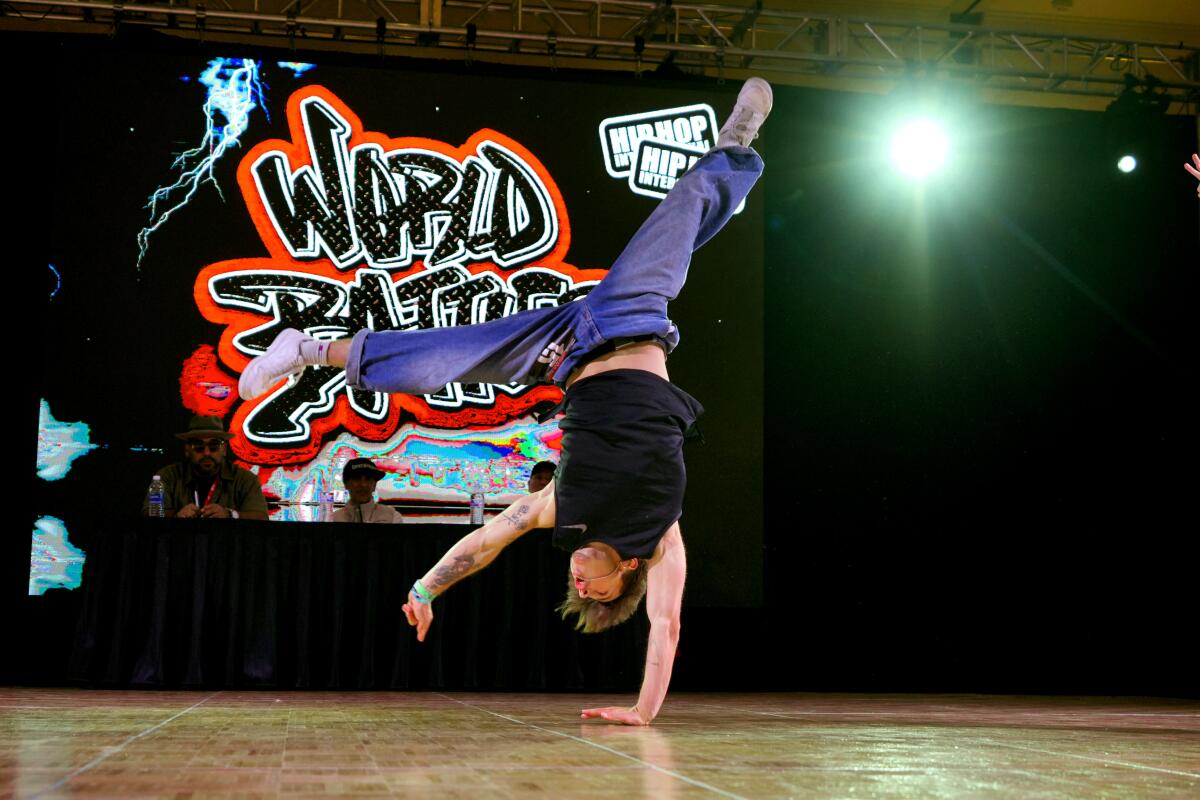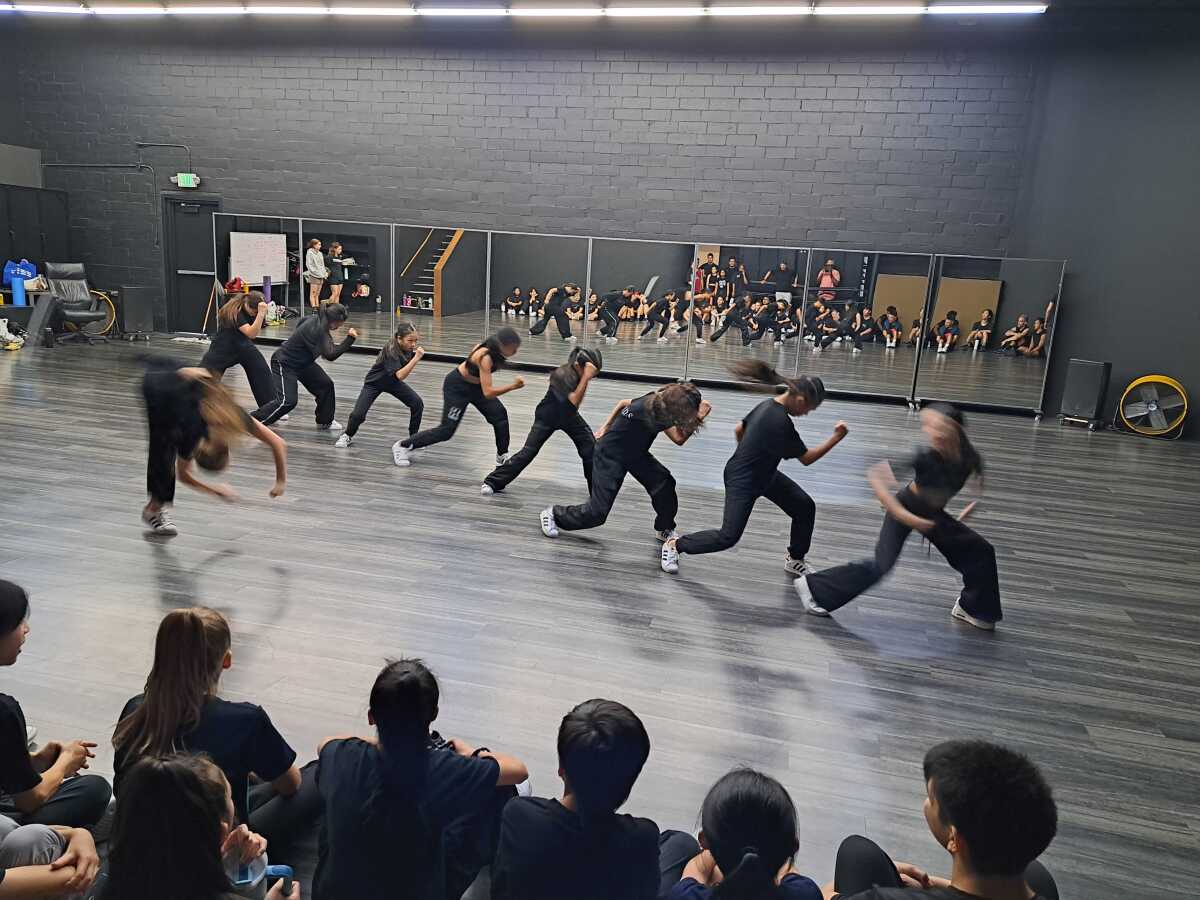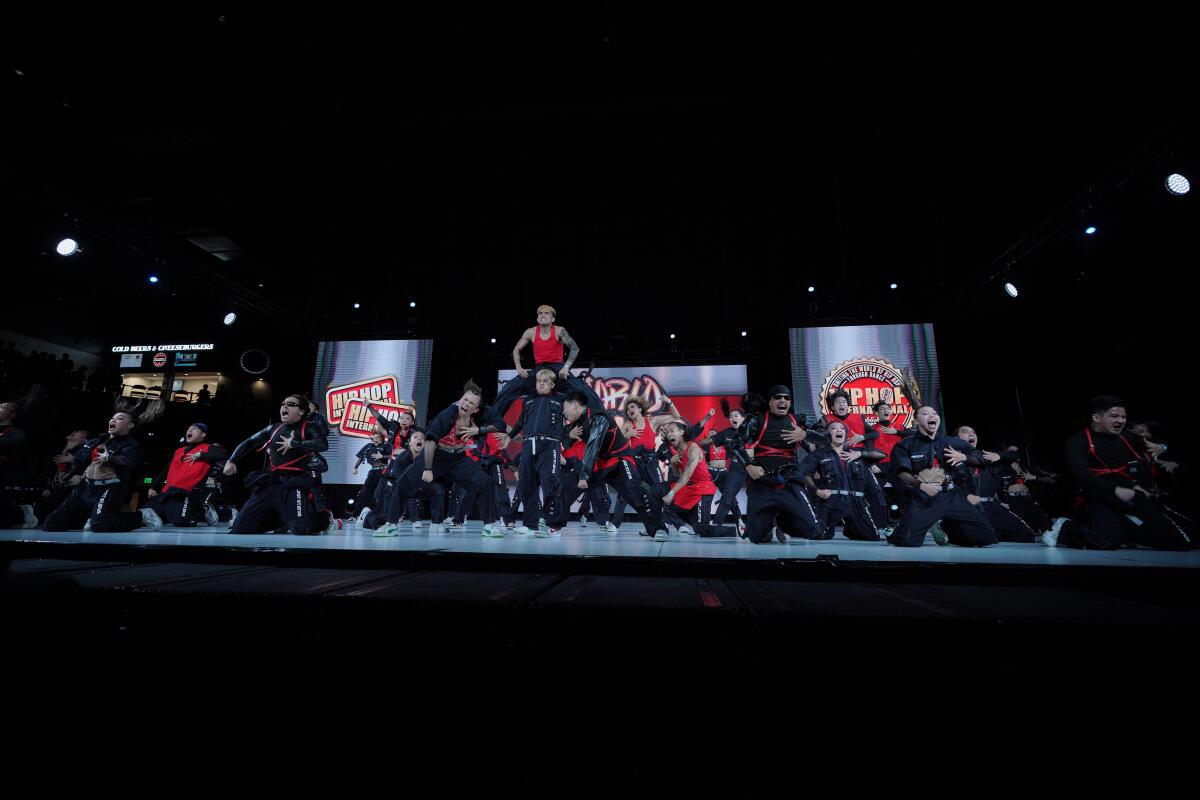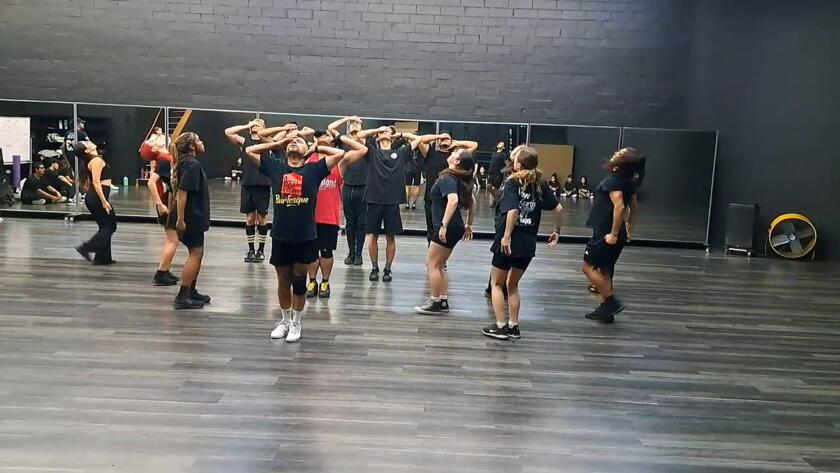Pasadena hip-hop dance teams stumble on the world stage: ‘They’re all coming for blood’

- Share via
As hip-hop turns 50 on Friday, one of its pillars, breakdancing, was on display last weekend in Phoenix at the World Hip Hop Dance Championship.
The event featured 3,000 dancers from at least 37 countries. In multiple ballrooms at the Arizona Grand Resort and Spa, international dance stars taught classes and routines, dancers practiced in hallways before battling one-on-one and in teams, and attendees socialized and networked.
For the record:
11:07 a.m. Aug. 10, 2023In a previous version of this story, a member of the Maker Empire was called Joseph Garcia. His name is Joshua Vasquez.
Despite the pomp and circumstance of the opening ceremony — thousands of dancers walked into Arizona State Universtity’s Mullett Arena waving national flags, dancing and welling up with pride for their countries — the competition is also about establishing a legacy, and the crews traveling from Pasadena to Arizona were hoping to do just that.

Led by founder Beau Fournier, co-owner of Elements Dance Space in Pasadena, Maker Empire had multiple teams that qualified for the world championships following top-five finishes at the USA Hip Hop Dance Championship held earlier this year in Burbank.
Hip Hop International has six categories in its crew championships: megacrew, JV megacrew, minicrew, adult, varsity and junior. The groups competing in the world championship from the Maker Empire were junior groups AMMP and Maker Empire Jrs. (7 to 12 years old); JV megacrew Trouble Makers (10 to 40 members, up to 17 years old); and megacrew Rogue Makers (all ages, up to 40 members). They packed up their costumes, freshened up their routines and headed to Phoenix, prepared to be judged on originality, showmanship, formations and musicality. Fournier and the crews were excited to be honored among the world’s best, and as the Elements Dance Space celebrates its sixth anniversary, Fournier has found his footing in the youth competition world.
Fournier has been part of many crews and dance organizations, including as a member of the dance group Fanny Pak more than a decade ago on the MTV competition show “America’s Best Dance Crew.” The quirky ensemble’s ’80s homages created a huge fandom, and their sharp movements and style carried them all the way to the final three on the show. Merchandising and choreography gigs opened up for the group and its individual dancers.

“I started teaching the youth competition team [at an Alhambra dance studio] and I started to like this world — the studio competition world. I started developing relationships and mentoring these younger kids that are very versatile. They strive for the competition,” Fournier said. Although he was touring with “World of Dance” and competing as a part of Fanny Pak and individually, Fournier decided to take the leap to create a legacy. “I was like, you know what? I need my own space to selfishly do what I want to do,” says Fournier.
Fournier’s dancers have excelled in competitions and the studio has gained a sizable following. But with judges at HHI hailing from Brazil, the Philippines, Ukraine and other countries, he feared the competition would be slightly different than what the crews experienced in their third-place finish at the USA championship. The dancers’ young age and inexperience on an international stage meant they’d be facing fierce competition, Fournier said.
It ended up being too much for his students. By midweek, the Maker Empire crews were out in the semifinals. The winners, awarded Sunday night, were from multiple countries considered to be strong dance hubs. Legit Status from the Philippines won the megacrew division, with Thailand’s Awesome Junior earning the JV megacrew title and France’s Phase 3 taking the minicrew championship. HQ from the Philippines nabbed gold in the adult division, Kana-Boon from Japan took home the varsity title and Japan’s Next Jr. won the junior section. Maker Empire Jrs. missed out on advancing to the finals by half a point because of a deduction from a “very, very small stumble.”
- Share via
A crew practices in Pasadena before competing in the Hip Hop International world championships.
“They didn’t fall, but it was categorized as a minor fall. He just tripped a little. It’s a stupid rule ... but I’m super proud that they made semis!” said Fournier. “This may seem really cliche, but I don’t really necessarily see anybody as the main competition. It’s more so [just knowing] they’re all coming for blood. You don’t know where they’re going to stack up either with the judges.”
During their off-time in Arizona, most of the Maker Empire dancers were busy watching competitors and in awe of the breakdancers. While much of hip-hop dance is characterized by arm and body movements and formations, breakdancing often involves more strength — arms, legs, core — for the groundwork, acrobatics and speed required to make it look effortless. This, along with musicality, is what many judges look for.
Meghan Gomez, an instructor and director at Elements, said the time will come for breaking to get a spotlight at the dance space, but to prepare, young dancers have to not only train physically, but also understand its origins.
“Leaders that are in charge of these kids ... it’s important for them to introduce breaking as a sport and as a culture,” says Gomez. “Not many of the kids know that it’s even a sport in the Olympics. On their phones, it’s pop culture and current events [that they’re into right now]. Not Olympic news.”

In addition to crew competitions, Maker Empire member Joshua Vasquez, 16, also competed as a freestyle dancer in the World Battles 1v1 tournament. The Olympics are a far-off dream (maybe 2028 in L.A.), and he considers their inclusion on the world stage “beautiful and perfect.”
Though b-boy Vico from France won the battle, the champion said he, like many b-boys, wasn’t a fan of the rules. Vico is more used to face-to-face battling than the structured dance that’s easier to score. The French dancer — whose answers were translated by a fellow member of his Death Squad dance crew, Narjiss Ghaza — enjoyed the HHI competition, but said it “does not look like hip-hop [to him].” Despite his excitement that breakdancing will be introduced as an Olympic sport in his home country next year, “it’s not my goal at the moment.”
For many, though, it is a goal. The global competition was another step for some to test themselves. Mookie, the stage name of the venerable emcee of HHI’s USA and world championships, has spoken to dancers who want to compete at the 2024 or 2028 Olympic Games. And though some are taking a wait-and-see approach, many are ready to prove themselves.
“It’s not a sport, it’s a culture. It’s the first element of hip-hop,” says Mookie. “Hip-hop is gonna be on display [if it’s done correctly]. You’re gonna need a DJ. That’s the second element. You’re gonna have graffiti — the posters and ads. That’s the third element. Then you’re gonna have to have an emcee to balance it all out. You have the four elements.”
For the optimistic, it’s a step toward a more inclusive Olympic Games that could lead to more acceptance for hardened b-boys and b-girls.
More to Read
The biggest entertainment stories
Get our big stories about Hollywood, film, television, music, arts, culture and more right in your inbox as soon as they publish.
You may occasionally receive promotional content from the Los Angeles Times.












